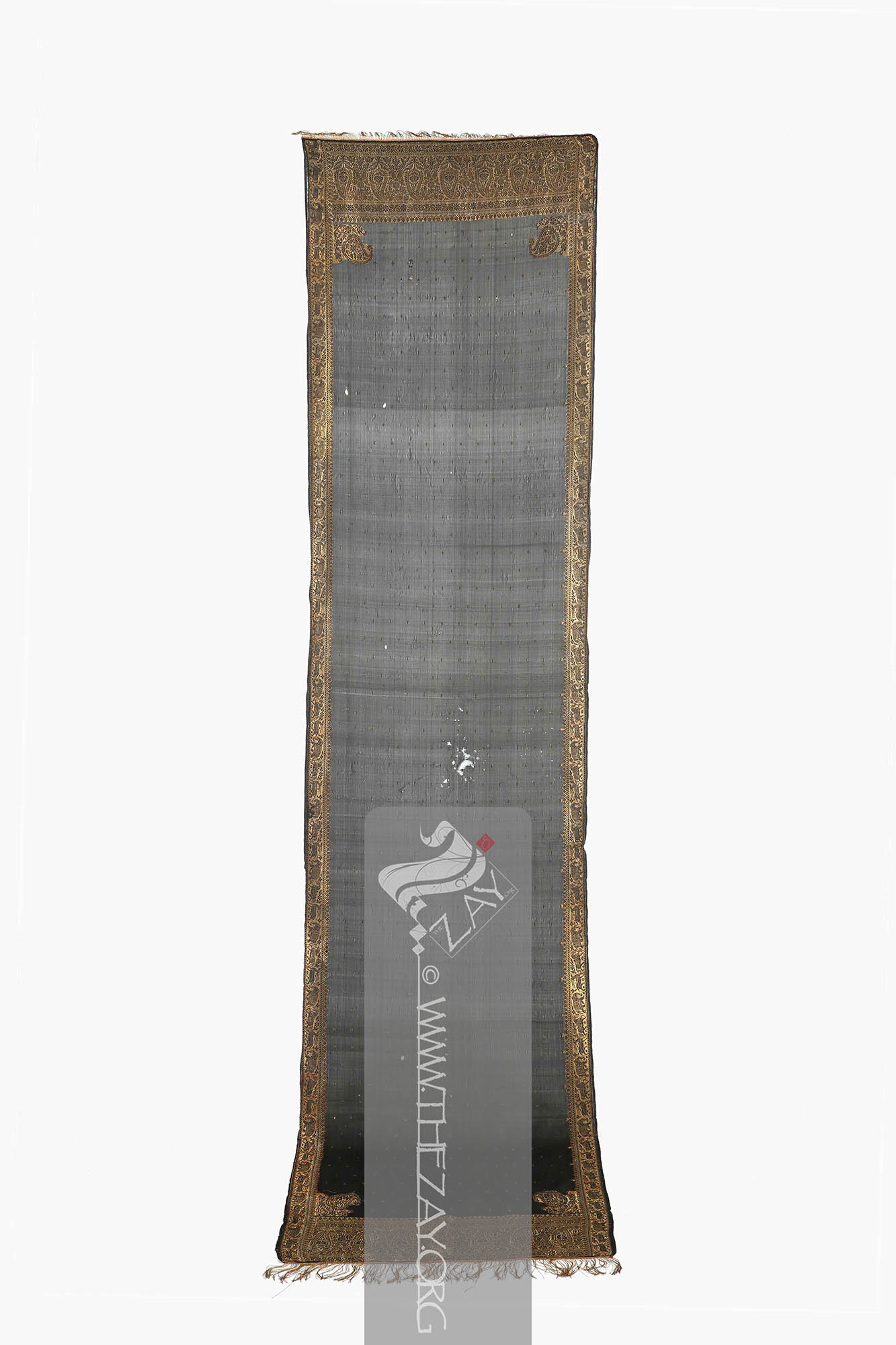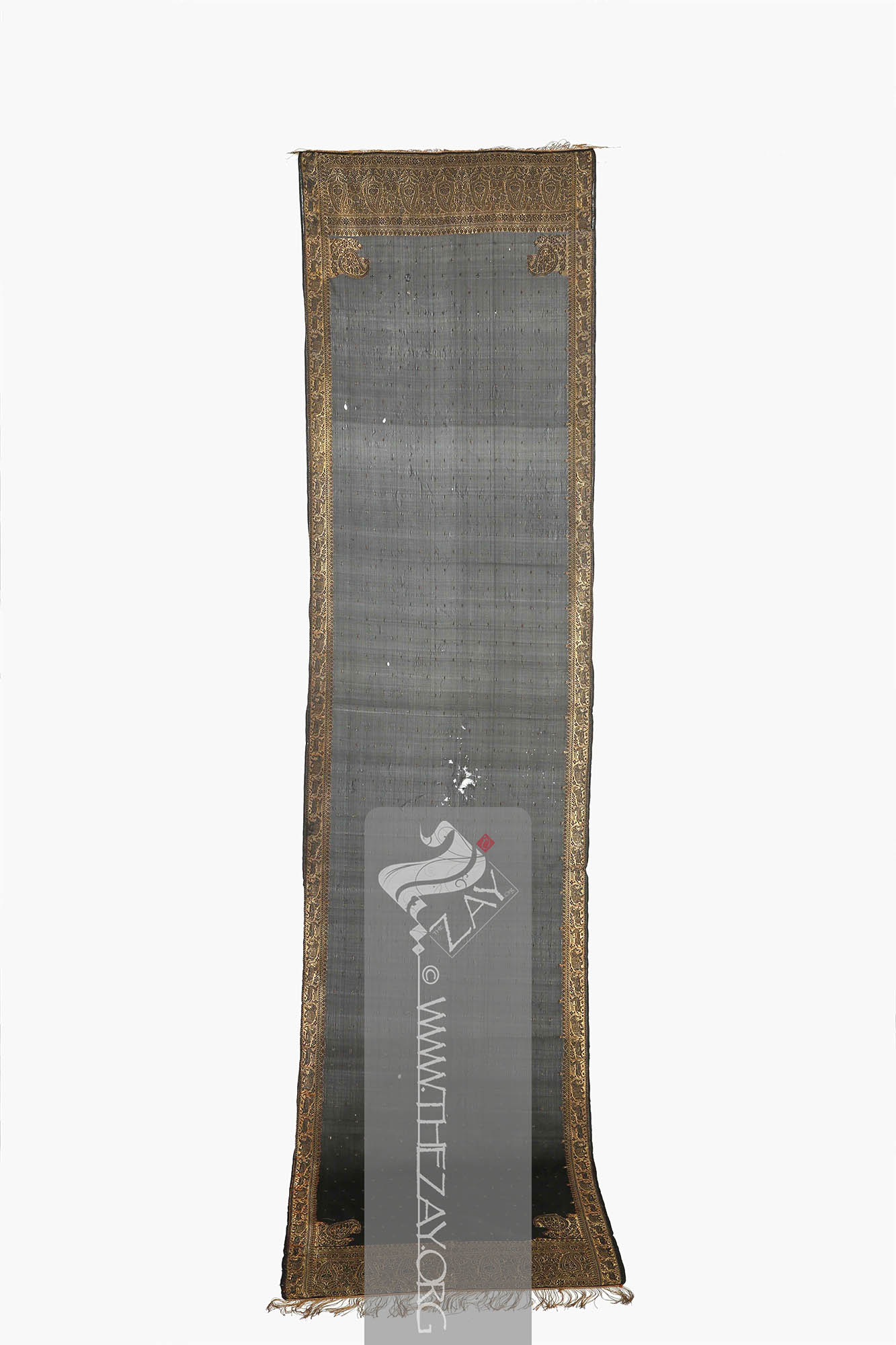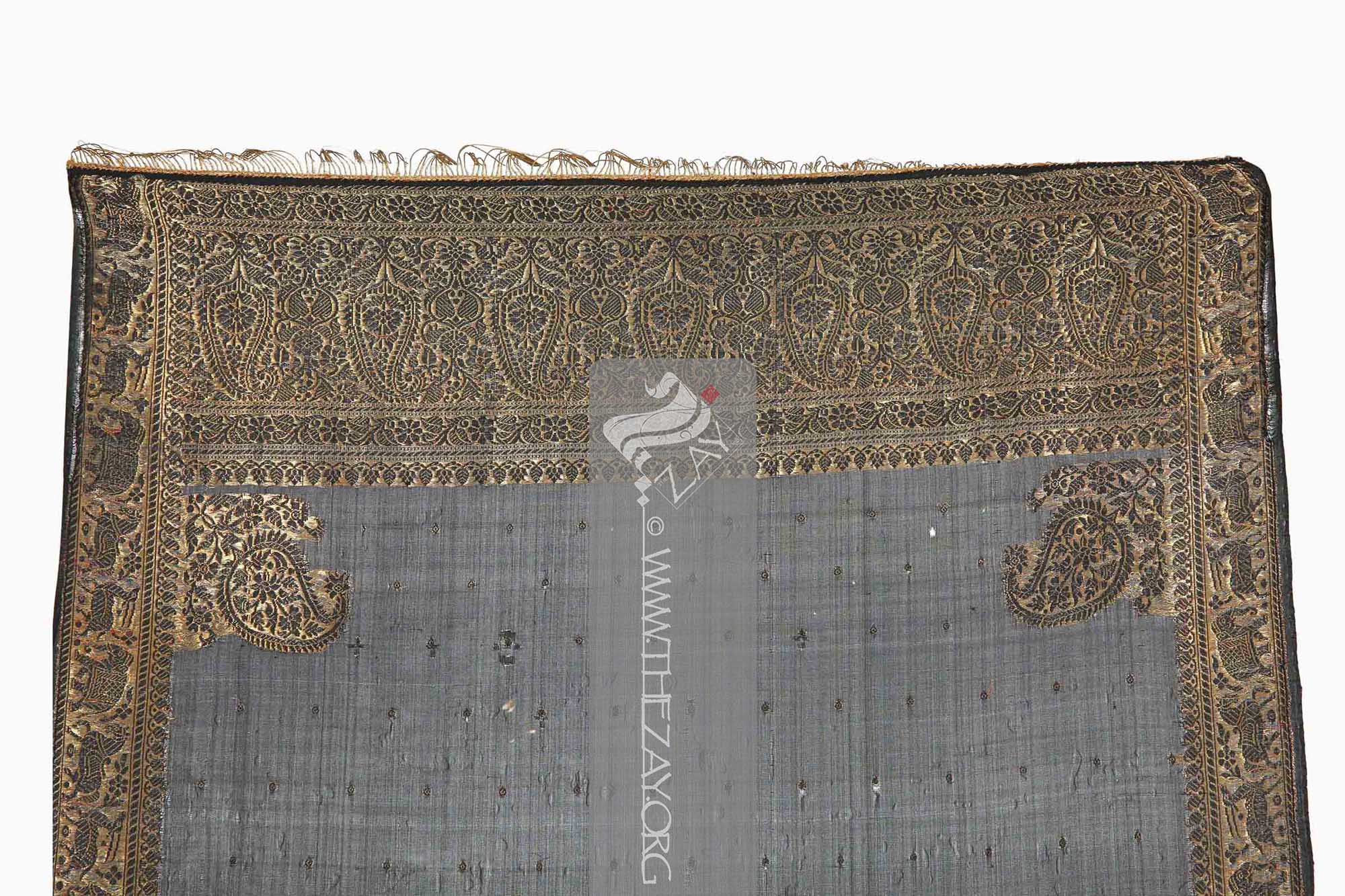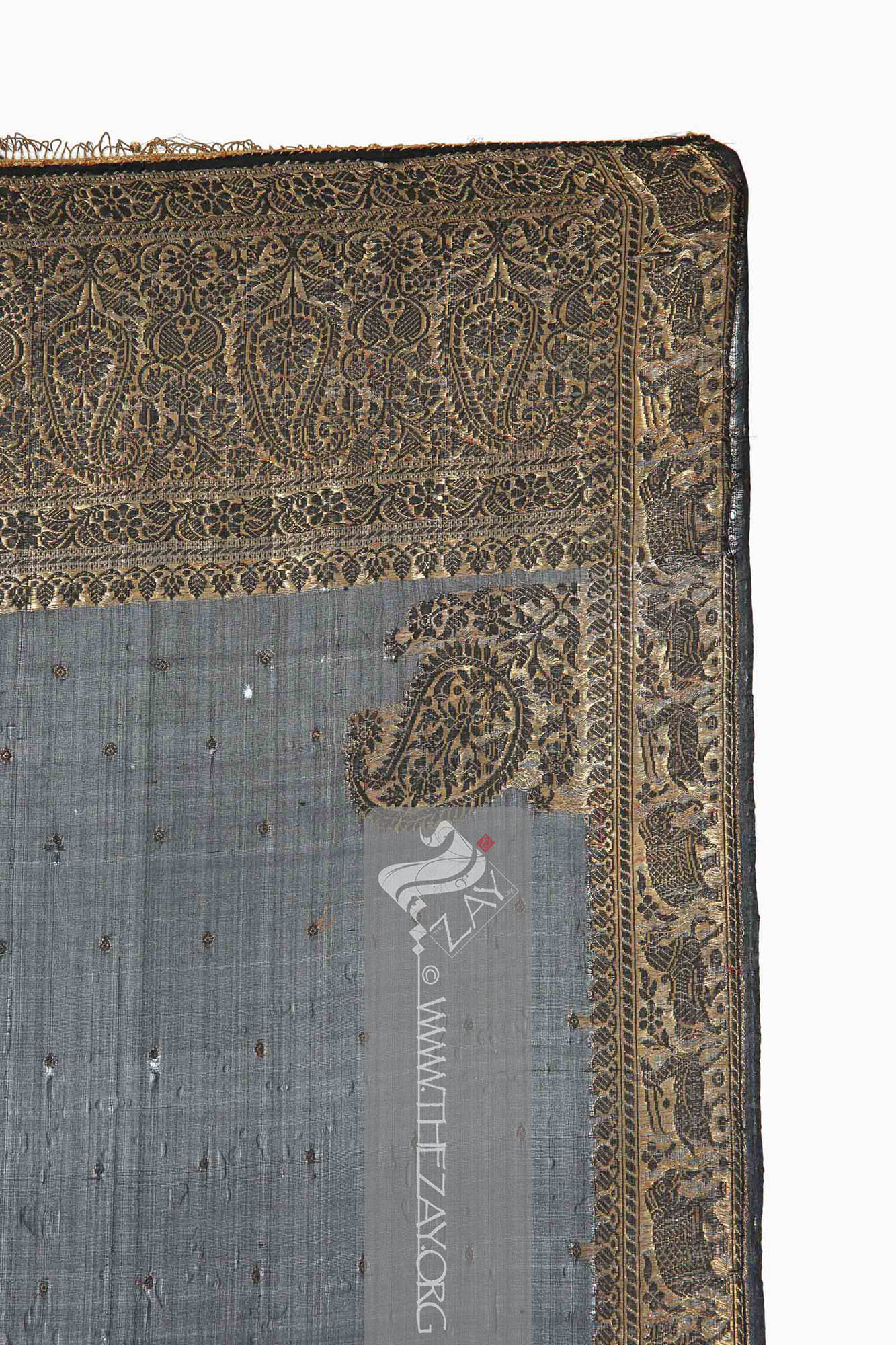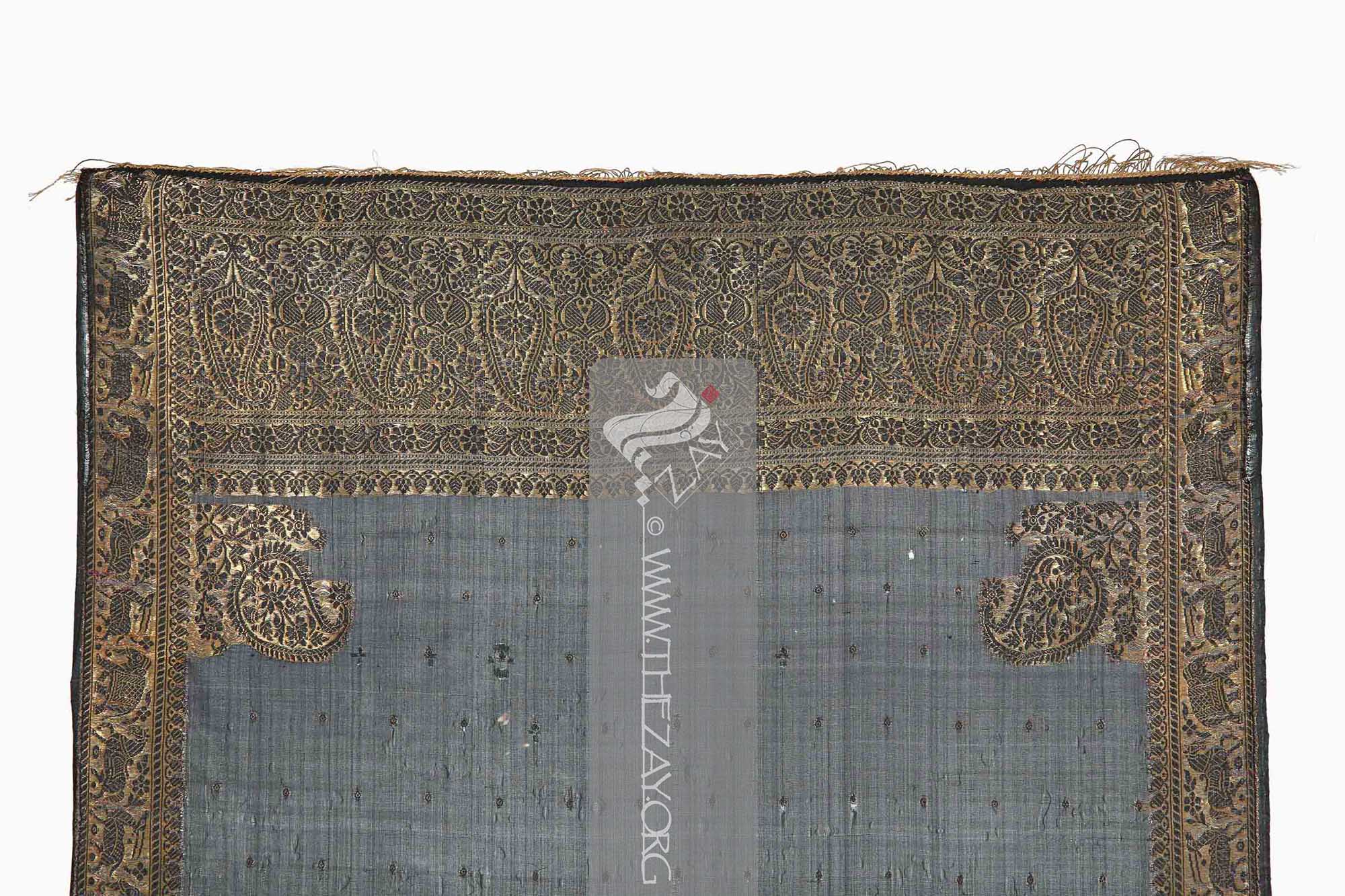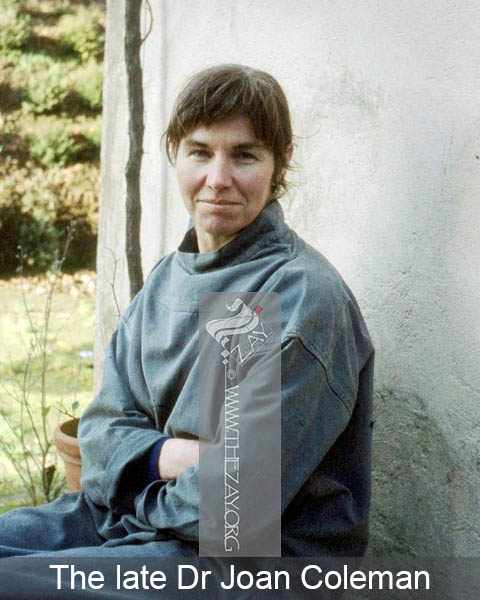Object NoteA set of four objects with three in possession of the
Zay
Zay: (Arabic: costume, Pl. azyaā’), a set of clothes in a style typical of a particular country or historical period. Initiative along with (
ZI2020.500783 ASIA,
ZI2020.500785 ASIA,
ZI2020.500786 ASIA).
Object HistoryThis silk (
brocade
Brocade: (Italian: brocco – twisted thread), is a richly decorative fabric woven with an intricate raised pattern. Its origins can be traced back to ancient China, where it was made for the imperial court. It later spread to Europe during the Renaissance and became popular in couture and decorative arts. )
scarf
Scarf: (English), usually a rectangular piece of cloth loosely worn over the shoulders, upper body and arms, and sometimes also over the head. possibly dating back to the 19th century was originally a part of the Dr Joan Coleman Collection. It was first purchased along with (
ZI2020.500783 ASIA). Later The
Zay
Zay: (Arabic: costume, Pl. azyaā’), a set of clothes in a style typical of a particular country or historical period. Initiative managed to acquire it from Kerry Taylor Auctions in 2020.
Dr Joan Coleman began collecting shawls in 1976 and developed her lifelong passion for collecting. She was a regular at the London salesrooms of Christie’s, Sotheby’s, and Phillips – three of the most outstanding auction houses of the period in the world – getting to know the dealers and learning in the process. She acquired vast knowledge and dedicated hours carefully cataloguing her ever-growing collection. She intended to loan her collection to different museums and institutions for the benefit of learning and education. Her collection is one of the largest and the finest private
shawl
Shawl: (Persian: shāl from Hindi: duśālā – Shoulder Mantle), a shawl is a South Asian version of a scarf worn or wrapped loosely over the shoulders and is usually made of wool. collections to have ever graced the world with shawls ranging from Kashmir,
Paisley
Paisley: (Scottish Gaelic, Pàislig: a town in Scotland), often called buta, boteh, amli, or kalgi in the subcontinent and kazuwah in Arabic, is a Persian tear drop motif with a curved end specially in textiles. Its popularity and subsequent local production in 18th century at Paisley are responsible for its nomenclature., Edinburgh, Norwich, France, and Iran.
Object Features This is a beautiful rectangular
brocade
Brocade: (Italian: brocco – twisted thread), is a richly decorative fabric woven with an intricate raised pattern. Its origins can be traced back to ancient China, where it was made for the imperial court. It later spread to Europe during the Renaissance and became popular in couture and decorative arts. silk
scarf
Scarf: (English), usually a rectangular piece of cloth loosely worn over the shoulders, upper body and arms, and sometimes also over the head.. Woven (
selvedge
Selvedge: (English: Self-finished edge or self-edge: a dialect forming transition), an edge produced on woven fabric during manufacture that prevents it from unravelling. Traditionally the term selvage applied to only loom woven fabric, presently it could be applied to flat knitted fabric too. ) to
selvedge
Selvedge: (English: Self-finished edge or self-edge: a dialect forming transition), an edge produced on woven fabric during manufacture that prevents it from unravelling. Traditionally the term selvage applied to only loom woven fabric, presently it could be applied to flat knitted fabric too. in black silk and gold thread this piece quite possibly originated in Banaras – Anglicized Varanasi – in c. 19th century.
The design distribution of this piece is typical of this period with a (
phala
Phāla: (Etymological origin: Possibly Indo Persian), the wider layer of pattern that forms the border at each warp
Warp: One of the two basic components used in weaving which transforms thread or yarns to a piece of fabric. The warp is the set of yarns stretched longitudinally in place on a loom before the weft
Weft: one of the two basic components used in weaving that transforms thread or yarns into a piece of fabric. It is the crosswise thread on a loom that is passed over and under the warp threads. is introduced during the weaving process. end or head of a shawl
Shawl: (Persian: shāl from Hindi: duśālā – Shoulder Mantle), a shawl is a South Asian version of a scarf worn or wrapped loosely over the shoulders and is usually made of wool. . ), two sets of (
tanjir
Tanjīr: (Possibly Persian: zanjir: Chain), a narrow layer of pattern that forms the border and runs above and below the wider layer. ), a couple of (hashiya), and a distinct (
matan
Matan: (Arabic, middle of the thing), the main field of a shawl
Shawl: (Persian: shāl from Hindi: duśālā – Shoulder Mantle), a shawl is a South Asian version of a scarf worn or wrapped loosely over the shoulders and is usually made of wool. . ). The
phala
Phāla: (Etymological origin: Possibly Indo Persian), the wider layer of pattern that forms the border at each warp
Warp: One of the two basic components used in weaving which transforms thread or yarns to a piece of fabric. The warp is the set of yarns stretched longitudinally in place on a loom before the weft
Weft: one of the two basic components used in weaving that transforms thread or yarns into a piece of fabric. It is the crosswise thread on a loom that is passed over and under the warp threads. is introduced during the weaving process. end or head of a shawl
Shawl: (Persian: shāl from Hindi: duśālā – Shoulder Mantle), a shawl is a South Asian version of a scarf worn or wrapped loosely over the shoulders and is usually made of wool. . consists of seven (
paisley
Paisley: (Scottish Gaelic, Pàislig: a town in Scotland), often called buta, boteh, amli, or kalgi in the subcontinent and kazuwah in Arabic, is a Persian tear drop motif with a curved end specially in textiles. Its popularity and subsequent local production in 18th century at Paisley are responsible for its nomenclature.)/(
buta
Būta: (Anglicized Persian: boteh – Pinecone shaped motif), known as paisley
Paisley: (Scottish Gaelic, Pàislig: a town in Scotland), often called buta, boteh, amli, or kalgi in the subcontinent and kazuwah in Arabic, is a Persian tear drop motif with a curved end specially in textiles. Its popularity and subsequent local production in 18th century at Paisley are responsible for its nomenclature. in English it is the almond or pinecone-shaped motif, especially in textiles. It is believed to have originated from the Cyprus tree a Zoroastrian symbol for life and eternity. In the current Indian context, however, it simply means motif.) motifs with a fully bloomed flower at the (
shikam
Shikam: (Persian: shikam or shikm – Belly or stomach), the belly of a buta or a paisley motif. ) of each
paisley
Paisley: (Scottish Gaelic, Pàislig: a town in Scotland), often called buta, boteh, amli, or kalgi in the subcontinent and kazuwah in Arabic, is a Persian tear drop motif with a curved end specially in textiles. Its popularity and subsequent local production in 18th century at Paisley are responsible for its nomenclature.. The (
jaal
Jaal: (Sanskrit: jaal – A net, web, or a mesh), the decoration which fills the ground between the paisley
Paisley: (Scottish Gaelic, Pàislig: a town in Scotland), often called buta, boteh, amli, or kalgi in the subcontinent and kazuwah in Arabic, is a Persian tear drop motif with a curved end specially in textiles. Its popularity and subsequent local production in 18th century at Paisley are responsible for its nomenclature. cones at the heads of a shawl
Shawl: (Persian: shāl from Hindi: duśālā – Shoulder Mantle), a shawl is a South Asian version of a scarf worn or wrapped loosely over the shoulders and is usually made of wool. .
) of the
phala
Phāla: (Etymological origin: Possibly Indo Persian), the wider layer of pattern that forms the border at each warp
Warp: One of the two basic components used in weaving which transforms thread or yarns to a piece of fabric. The warp is the set of yarns stretched longitudinally in place on a loom before the weft
Weft: one of the two basic components used in weaving that transforms thread or yarns into a piece of fabric. It is the crosswise thread on a loom that is passed over and under the warp threads. is introduced during the weaving process. end or head of a shawl
Shawl: (Persian: shāl from Hindi: duśālā – Shoulder Mantle), a shawl is a South Asian version of a scarf worn or wrapped loosely over the shoulders and is usually made of wool. . has different foliage and floral patterns that are intricately and densely woven in gold. The
tanjir
Tanjīr: (Possibly Persian: zanjir: Chain), a narrow layer of pattern that forms the border and runs above and below the wider layer. comprises a central wavy vine along which leaves and flowers are placed alternately.
The hashiya are lined up with animal motifs – an elephant, a horse and another animal that could be identified either as a gazelle or an antelope – that are repeated in the same order. The
matan
Matan: (Arabic, middle of the thing), the main field of a shawl
Shawl: (Persian: shāl from Hindi: duśālā – Shoulder Mantle), a shawl is a South Asian version of a scarf worn or wrapped loosely over the shoulders and is usually made of wool. . or the central field of the piece has a frame of small paisleys and lotuses arranged alternately along an interlocked ‘U’ shaped vine. The rest of the field is scattered with repeated leaf-shaped oblong dots that are further enhanced by four big tilted (
kunjbuta
Kunjbuta: (Sanskrit: kunj – place or corner associated with greenery; and Sanskrit: buta – foliage motif), the word is probably a portmanteau of two Sanskrit words it usually refers to the corner ornaments or decoration on a shawl
Shawl: (Persian: shāl from Hindi: duśālā – Shoulder Mantle), a shawl is a South Asian version of a scarf worn or wrapped loosely over the shoulders and is usually made of wool. . ) ones on each corner. Hand-stitched hems with (
zari
Zarī: (Persian two-syllables: zar: gold & dozi: embellishment), complex embroidery technique that uses metal alloy on silk, satin, or velvet, and may include pearls, beads, and precious stones. Colloquially in the Arab gulf region, the term (zarī) is loosely applied to any gilded thread, embellishment or gilded brocade fabric. Originated in ancient Persia it has been used extensively in Indian and Middle Eastern textiles for centuries. ) fringes hanging loose from the two (
warp
Warp: One of the two basic components used in weaving which transforms thread or yarns to a piece of fabric. The warp is the set of yarns stretched longitudinally in place on a loom before the weft
Weft: one of the two basic components used in weaving that transforms thread or yarns into a piece of fabric. It is the crosswise thread on a loom that is passed over and under the warp threads. is introduced during the weaving process. ) end finish the
scarf
Scarf: (English), usually a rectangular piece of cloth loosely worn over the shoulders, upper body and arms, and sometimes also over the head..
More InfoThe silk industry in Varanasi or Banaras has been one of the oldest and most renowned silk-weaving industrial hubs in India for over 2,000 years, with the industry dating back to the 6th century BCE. Situated on the banks of the river Ganges which provides fertile soil and ideal condition, the city thrives from its mulberry cultivation which forms the primary food source for the silkworms.
The silk weaving technique used in Varanasi is called (
Banarasi_silk
Banarasī_silk: It is a luxurious brocade
Brocade: (Italian: brocco – twisted thread), is a richly decorative fabric woven with an intricate raised pattern. Its origins can be traced back to ancient China, where it was made for the imperial court. It later spread to Europe during the Renaissance and became popular in couture and decorative arts. fabric woven in silk in Varanasi, India, using a special weaving technique. It is known for its intricate designs and use of gold and silver threads. ) or simply (Banarasi). It involves intricate designs and patterns woven onto pure silk fabrics. One of the most striking features of
Banarasi_silk
Banarasī_silk: It is a luxurious brocade
Brocade: (Italian: brocco – twisted thread), is a richly decorative fabric woven with an intricate raised pattern. Its origins can be traced back to ancient China, where it was made for the imperial court. It later spread to Europe during the Renaissance and became popular in couture and decorative arts. fabric woven in silk in Varanasi, India, using a special weaving technique. It is known for its intricate designs and use of gold and silver threads. is the use of gold and silver threads, called
zari
Zarī: (Persian two-syllables: zar: gold & dozi: embellishment), complex embroidery technique that uses metal alloy on silk, satin, or velvet, and may include pearls, beads, and precious stones. Colloquially in the Arab gulf region, the term (zarī) is loosely applied to any gilded thread, embellishment or gilded brocade fabric. Originated in ancient Persia it has been used extensively in Indian and Middle Eastern textiles for centuries. , which are woven into the fabric to create brocades with intricate designs and patterns. The
zari
Zarī: (Persian two-syllables: zar: gold & dozi: embellishment), complex embroidery technique that uses metal alloy on silk, satin, or velvet, and may include pearls, beads, and precious stones. Colloquially in the Arab gulf region, the term (zarī) is loosely applied to any gilded thread, embellishment or gilded brocade fabric. Originated in ancient Persia it has been used extensively in Indian and Middle Eastern textiles for centuries. is made from fine metallic wire, which is wrapped around a silk thread and then woven into the fabric using the same technique as the silk threads.
Today, the industry continues to thrive, with many skilled artisans passing down their knowledge and techniques from generation to generation that have helped them secure Geographical Indication rights – internationally recognized intellectual property rights to protect products originating from a specific region possessing certain qualities – to ‘Banaras Brocades and Saris’. The industry is an important source of employment and income for many people in the region, and the exquisite fabrics produced here are highly sought after both in India and around the world.
Links
- Faisal, Sana. "The Decline of Varanasi Silk Handloom Cottage Industry: A Case Study of Brocade
Brocade: (Italian: brocco – twisted thread), is a richly decorative fabric woven with an intricate raised pattern. Its origins can be traced back to ancient China, where it was made for the imperial court. It later spread to Europe during the Renaissance and became popular in couture and decorative arts. Weaving Community in Varanasi." Chitrolekha International Magazine on Art and Design, vol. Vol. 6, no. 2, 2016, https://doi.org/http://dx.doi.org/10.21659/chitro.v6n2.07.
- TEXTILES AND CLOTHING ALONG THE SILK ROADS. Edited by Fang Zhao and Marie L. Nosch, UNESCO and China National Silk Museum, 2022.
- Sethi, Ritu. Handmade for the 21st Century: Safeguarding Traditional Indian Textiles. UNESCO, 2022.




